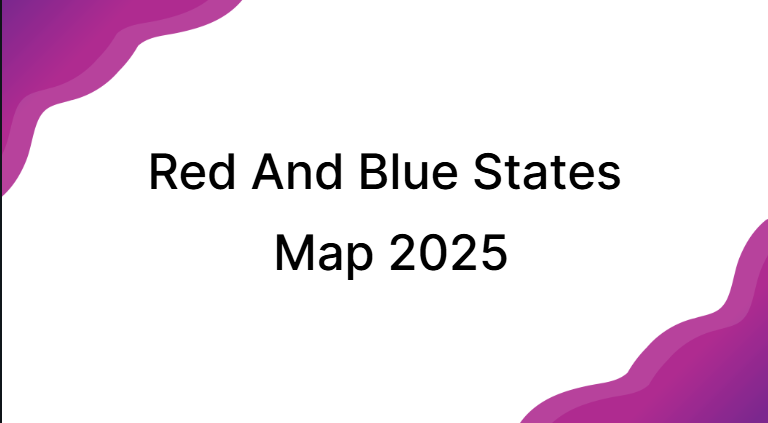In the United States, people often talk about red states and blue states. These are simple colors to show which major political party usually wins in each state. By 2025, that map has changed a little, though many lines stay the same. In this article, we will explain the red and blue map of 2025, why it matters, and answer common questions.
1. What Are Red States and Blue States?
- Red state: A state where the Republican Party generally wins in presidential and state elections.
- Blue state: A state where the Democratic Party generally wins.
- Swing or purple state: A state that may go red or blue depending on the election.
These terms became popular around the year 2000. Wikipedia
2. The 2025 Political Map: What Changed?
In the 2024 presidential election, Republicans extended their control.
- Number of states:
Republicans won in 31 states.
Democrats won in 19 states. - Major flips:
Several states that voted blue before switched to red by 2025:- Arizona
- Georgia
- Michigan
- Nevada
- Wisconsin
- Population vs. states:
Although more states are red, many blue states have large populations and many electoral votes. Thus, the balance of power is not just about the quantity of states but also which states and how many votes they carry.
3. Why the Map Matters
3.1 Influence on National Elections
The red and blue lines show where each party has strongholds. During campaigns, parties focus on swing states to tip the balance in their favor.
3.2 State Policies
Red states and blue states often set different rules about taxes, education, health care, and social issues. Because each state has powers of its own, these maps also show how Americans may live differently depending on where they are.
3.3 Redistricting and Gerrymandering
States redraw district lines every so often. In 2025, many red states are pushing to redraw maps to favor their party in future elections. That strategy is known as gerrymandering.
For example:
- Texas passed a new congressional map to give Republicans an advantage in several seats.
- Missouri also redrew its map to reduce safe districts for Democrats.
- North Carolina is considering new maps to make certain districts lean more Republican.
Such changes can shift how many seats a party wins even if people’s votes don’t change much.
4. Patterns in the 2025 Map
4.1 The South, Midwest, and Interior are Red
States in the South, parts of the Midwest, and many in the central U.S. tend to be red. These are areas where Republican support is strong.
4.2 Blue in Urban and Coastal Areas
Blue states or blue-leaning states often cluster along the coasts and in large cities. These areas tend to have denser populations and different economic needs.
4.3 Swing States Become Precious
States like Pennsylvania, Ohio, North Carolina, Michigan, and Wisconsin remain crucial battlegrounds. Parties pour money and resources into these states.
5. What to Watch Going Forward
- 2026 Elections: How redrawn districts affect House and Senate races.
- Population changes: More people moving or shifting demographics can change state leanings.
- Legislation: New state laws about voting, district maps, and state rights will influence future maps.
- Court rulings: Legal challenges may block or change gerrymandering efforts.
FAQs
Q1: What caused many states to flip from blue to red by 2025?
A: A mix of shifting voter sentiments, strong Republican campaigns, and changing demographics in those states. Also, red states used new maps to push for advantage.
Q2: Does “winning more states” mean winning the national election?
A: Not always. Some blue states have large populations and many electoral votes. So winning key populous states can make a big difference.
Q3: Will the 2025 map stay the same until 2028?
A: Not necessarily. Changes can come with redistricting, voter trends, and legal decisions.
Q4: Is gerrymandering legal?
A: Some forms are legal under many state rules; others are challenged as unfair. Courts sometimes strike down maps that violate constitutional or voting-rights laws.
Q5: What is a “purple” or “swing” state now?
A: In 2025, states like Pennsylvania, North Carolina, Georgia, Ohio, and Wisconsin are often seen as swing states, meaning neither party can be sure of a win.
Conclusion
The red and blue states map in 2025 tells a story of continuity and change. Republicans expanded in many states, but Democrats kept strength in dense, populous regions. The map shapes how elections are fought, how laws are made, and how people live in each state.
Though the colors may look simple, behind them lie deep trends in politics, society, and power. As we move forward, observing which states shift, how districts are drawn, and how voters change will help us understand America’s evolving map.


